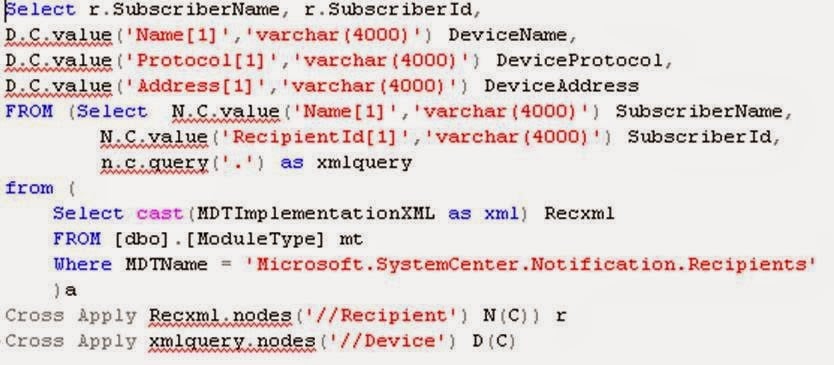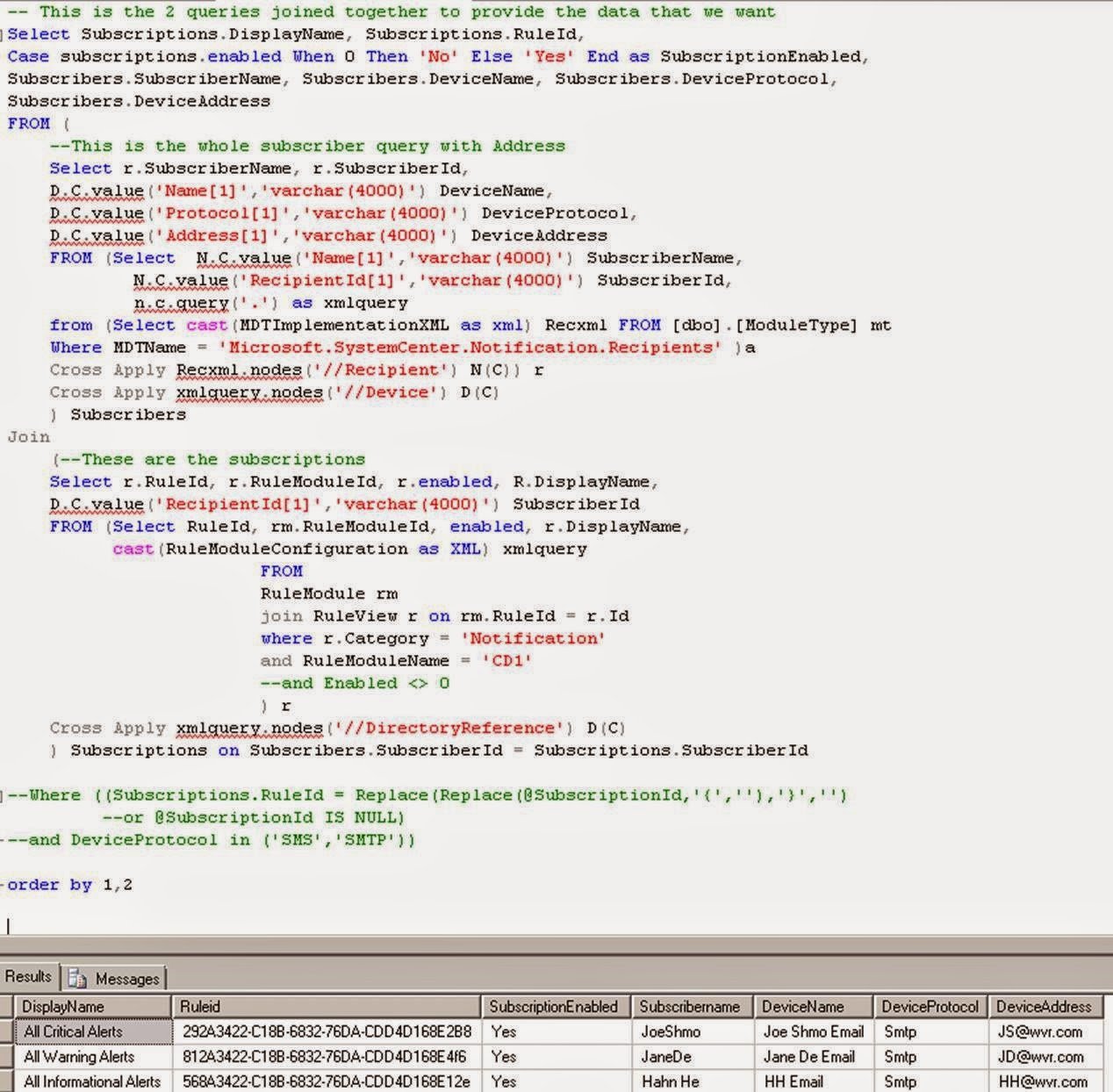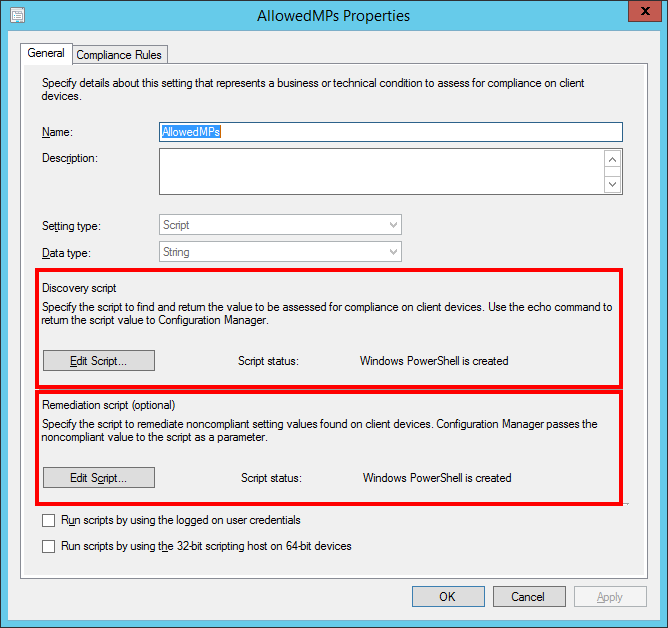When you have the database of an application at your fingertips, you can come up with all kinds of great information - trends, snapshots, forecasting. But when it comes to the SCOM transactional database, data can sometimes be elusive. I used the data from this blog post to give clients and management immediate access to the notification information. But using this data in an SSRS report, you should be able to reduce the number of times you are asked "who received this alert notification?"
I was hoping to find a simple answer, so I went to search online. It seemed that no one had posted anything related to querying notifications from the OperationsManager database. I am well aware of the Powershell cmdlets that can be used to get subscription information, but I love SQL, queries, and SSRS. I started digging around but had quite a bit of trouble finding any subscription information, so I began doing database searches using subscription GUIDs. Surprisingly, I only found the data in a few tables. This is not normally what most of us are used to querying from SCOM, so I had to do a little learning, and I want pass the queries on to you.
The queries and data are from the OperationsManager database. You can use them with ReadOnly credentials.
The Tables/Views
First of all, lets take a look at the tables. My GUID search led me to the tables and columns below; this was very disheartening, but I kept moving forward.
-
ManagementPack.MPRunTimeXML
-
Module.ModuleConfiguration
-
ManagementPack.MPXML
-
ModuleType.MDTImplementationXML
Of the above 4 tables, we really only need 1 - Module.
However, Microsoft recommends that we stick to views if we can help it, and we do have a view that is associated with the module table, which is "RuleModule."
There are a few other table/views that we need just to get some key data, so our complete list of needed views/tables are:
-
RuleModule
-
ModuleType
-
RuleView
The rest of the details come from the xml configuration in RuleModule, which turns something that should be relatively simple, into something a little more complicated. This is not a tutorial on how to query and parse xml columns, so I will not go into those details.
SCOM notification essentially have 4 components:
-
Channel - SMTP, command, SMS, etc. In the xml, this is actually called "Protocol".
-
Subscriber - This is the recipient. A subscriber can have multiple addresses and protocols,
-
Address - Email Address, phone number, command location. In the xml this is called "Device". Addresses are found as part of a subscriber.
-
Subscription - The subscription is actually a SCOM rule that triggers based on the criteria specified. The rule module is where we find the components of the subscription we need.
The Queries
Subscription Query
Let's start with the subscription. Like I said earlier, a subscription is a rule. Rather than writing a query to only get one subscription, I decided to get all subscriptions, which could then be filtered.

Select r.RuleId, r.RuleModuleId, r.enabled, R.DisplayName,D.C.value('RecipientId[1]','varchar(4000)') SubscriberId
FROM (
Select RuleId, rm.RuleModuleId, enabled, r.DisplayName, cast(RuleModuleConfiguration as XML) xmlquery
FROM
RuleModule rm
join RuleView r on rm.RuleId = r.Id
where r.Category = 'Notification'
and RuleModuleName = 'CD1'
) r
Cross Apply xmlquery.nodes('//DirectoryReference') D(C)
You can filter this query to give you a single subscription Id by name, Id, enabled/disabled, etc.
Subscriber and Device Query
The next query gets the subscriber and the subscriber's devices. When you run the query, rows may look like they are repeating. The row will repeat for each device. Because a subscriber could have an unknown number of devices, I did want to give variable columns counts. Therefore, you can use your own grouping and SQL magic to manipulate the results.

Select r.SubscriberName, r.SubscriberId,
D.C.value('Name[1]','varchar(4000)') DeviceName,
D.C.value('Protocol[1]','varchar(4000)') DeviceProtocol,
D.C.value('Address[1]','varchar(4000)') DeviceAddress
FROM (Select N.C.value('Name[1]','varchar(4000)') SubscriberName,
N.C.value('RecipientId[1]','varchar(4000)') SubscriberId,
n.c.query('.') as xmlquery
from (
Select cast(MDTImplementationXML as xml) Recxml
FROM [dbo].[ModuleType] mt
Where MDTName = 'Microsoft.SystemCenter.Notification.Recipients'
)a Cross Apply Recxml.nodes('//Recipient') N(C)) r
Cross Apply xmlquery.nodes('//Device') D(C)
Complete Query of Subscriptions with Subscribers and Devices
Both queries can be used alone to provide good information. However, what I really wanted was a list of subscriptions and who those subscription go to. For this I combined the two queries to give a nice result set that I could use in an SSRS report. Once I wrote the SSRS report, I used SSRS URL parameters to call the report directly from a SCOM notification.

-- This is the 2 queries joined together to provide the data that we want
Select Subscriptions.DisplayName, Subscriptions.RuleId,
Case subscriptions.enabled When 0 Then 'No' Else 'Yes' End as SubscriptionEnabled,
Subscribers.SubscriberName, Subscribers.DeviceName, Subscribers.DeviceProtocol,
Subscribers.DeviceAddress
FROM (
--This is the whole subscriber query with Address
Select r.SubscriberName, r.SubscriberId,
D.C.value('Name[1]','varchar(4000)') DeviceName,
D.C.value('Protocol[1]','varchar(4000)') DeviceProtocol,
D.C.value('Address[1]','varchar(4000)') DeviceAddress
FROM (Select N.C.value('Name[1]','varchar(4000)') SubscriberName,
N.C.value('RecipientId[1]','varchar(4000)') SubscriberId,
n.c.query('.') as xmlquery
from (Select cast(MDTImplementationXML as xml) Recxml FROM [dbo].[ModuleType] mt
Where MDTName = 'Microsoft.SystemCenter.Notification.Recipients' )a Cross Apply Recxml.nodes('//Recipient') N(C)) r
Cross Apply xmlquery.nodes('//Device') D(C)
) Subscribers
Join
(--These are the subscriptions
Select r.RuleId, r.RuleModuleId, r.enabled, R.DisplayName,
D.C.value('RecipientId[1]','varchar(4000)') SubscriberId
FROM (Select RuleId, rm.RuleModuleId, enabled, r.DisplayName,
cast(RuleModuleConfiguration as XML) xmlquery
FROM
RuleModule rm
join RuleView r on rm.RuleId = r.Id
where r.Category = 'Notification'
and RuleModuleName = 'CD1'
--and Enabled <> 0
) r
Cross Apply xmlquery.nodes('//DirectoryReference') D(C)
) Subscriptions on Subscribers.SubscriberId = Subscriptions.SubscriberId
--Where ((Subscriptions.RuleId = Replace(Replace(@SubscriptionId,'{',''),'}','')
--or @SubscriptionId IS NULL)
--and DeviceProtocol in ('SMS','SMTP'))
order by 1,2
Please let me know if you have any questions or have any issues running the above queries. Let me know if you would to take a step further and generate a SCOM report or access the reports from a notification.
As always you can reach me via email at brody.kilpatrick@sparkhound.com.
Information and material in our blog posts are provided "as is" with no warranties either expressed or implied. Each post is an individual expression of our Sparkies. Should you identify any such content that is harmful, malicious, sensitive or unnecessary, please contact marketing@sparkhound.com
Share this
You May Also Like
These Related Stories

Spectre and Meltdown - Is SQL Affected?

Automatically and Dynamically Adjust AllowedMPs Registry Key
-1%EF%B9%96width=1640&height=924&name=IT%20(8)-1.png)